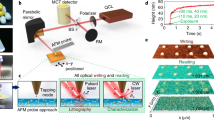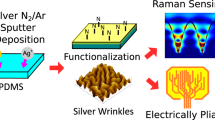Abstract
Traditional nanofabrication techniques often require complex lithographic steps and the use of toxic chemicals. To move from the laboratory scale to large scales, nanofabrication should be carried out using alternative procedures that are simple, inexpensive and use non-toxic solvents. Recent efforts have focused on nanoimprinting and the use of organic resists (such as quantum dot–polymer hybrids, DNA and poly(ethylene glycol)), which still require, for the most part, noxious chemicals for processing. Significant advances have been achieved using ‘green’ resists that can be developed with water, but so far these approaches have suffered from low electron sensitivity, line edge roughness and scalability constraints. Here, we present the use of silk as a natural and biofunctional resist for electron-beam lithography. The process is entirely water-based, starting with the silk aqueous solution and ending with simple development of the exposed silk film in water. Because of its polymorphic crystalline structure, silk can be used either as a positive or negative resist through interactions with an electron beam. Moreover, silk can be easily modified, thereby enabling a variety of ‘functional resists’, including biologically active versions. As a proof of principle of the viability of all-water-based silk electron-beam lithography (EBL), we fabricate nanoscale photonic lattices using both neat silk and silk doped with quantum dots, green fluorescent proteins (GFPs) or horseradish peroxidase (HRP).
This is a preview of subscription content, access via your institution
Access options
Subscribe to this journal
Receive 12 print issues and online access
$259.00 per year
only $21.58 per issue
Buy this article
- Purchase on Springer Link
- Instant access to full article PDF
Prices may be subject to local taxes which are calculated during checkout




Similar content being viewed by others
References
Liu, J. Q., Shao, J. Z. & Zheng, J. H. Radiation grafting/crosslinking of silk using electron-beam irradiation. J. Appl. Polym. Sci. 91, 2028–2034 (2004).
Brenckle, M. A. et al. Protein–protein nanoimprinting of silk fibroin films. Adv. Mater. 25, 2409–2414 (2013).
Tao, H., Kaplan, D. L. & Omenetto, F. G. Silk materials—a road to sustainable high technology. Adv. Mater. 24, 2824–2837 (2012).
Chen, W. & Ahmed, H. Fabrication of 5–7 nm wide etched lines in silicon using 100 keV electron-beam lithography and polymethylmethacrylate resist. Appl. Phys. Lett. 62, 1499–1501 (1993).
Duan, H. G. et al. Sub-10-nm half-pitch electron-beam lithography by using poly(methyl methacrylate) as a negative resist. J. Vac. Sci. Technol. B 28, C6C58 (2010).
Amsden, J. J. et al. Rapid nanoimprinting of silk fibroin films for biophotonic applications. Adv. Mater. 22, 1746–1749 (2010).
Amsden, J. J. et al. Spectral analysis of induced color change on periodically nanopatterned silk films. Opt. Express 17, 21271–21279 (2009).
Boriskina, S. V., Lee, S. Y. K., Amsden, J. J., Omenetto, F. G. & Dal Negro, L. Formation of colorimetric fingerprints on nano-patterned deterministic aperiodic surfaces. Opt. Express 18, 14568–14576 (2010).
Zhang, J. E. et al. Stabilization of vaccines and antibiotics in silk and eliminating the cold chain. Proc. Natl Acad. Sci. USA 109, 11981–11986 (2012).
Tao, H. et al. Implantable, multifunctional, bioresorbable optics. Proc. Natl Acad. Sci. USA 109, 919584–19589 (2012).
Pritchard, E. M., Dennis, P. B., Omenetto, F., Naik, R. R. & Kaplan, D. L. Review of physical and chemical aspects of stabilization of compounds in silk. Biopolymers 97, 479–498 (2012).
Pedelacq, J. D., Cabantous, S., Tran, T., Terwilliger, T. C. & Waldo, G. S. Engineering and characterization of a superfolder green fluorescent protein. Nature Biotechnol. 24, 79–88 (2005).
Lu, Q. et al. Stabilization and release of enzymes from silk films. Macromol. Biosci. 10, 359–368 (2010).
Omenetto, F. G. & Kaplan, D. L. A new route for silk. Nature Photon. 2, 641–643 (2008).
Lawrence, B. D., Cronin-Golomb, M., Georgakoudi, I., Kaplan, D. L. & Omenetto, F. G. Bioactive silk protein biomaterial systems for optical devices. Biomacromolecules 9, 1214–1220 (2008).
Chen, X., Palmer, R. E. & Robinson, A. P. G. A high resolution water soluble fullerene molecular resist for electron beam lithography. Nanotechnology 19, 275308 (2008).
Lawson, R. A., Lee, C. T., Yueh, W., Tolbert, L. & Henderson, C. L. Water developable negative tone single molecule resists: high sensitivity non-chemically amplified resists. Adv. Resist Mater. Proc. Technol. 6923, 19231 (2008).
Lin, Q. H. et al. A water-castable, water-developable chemically amplified negative-tone resist. Chem. Mater. 9, 1725–1730 (1997).
Takei, S., Oshima, A., Wakabayashi, T., Kozawa, T. & Tagawa, S. Eco-friendly electron beam lithography using water-developable resist material derived from biomass. Appl. Phys. Lett. 101, 033106 (2012).
Omenetto, F. G. & Kaplan, D. L. New opportunities for an ancient material. Science 329, 528–531 (2010).
Acknowledgements
The authors acknowledge support from the National Science Foundation (NSF) (DMR-1242240), ONR (N00014-13-1-0596) and AFOSR (FA9950-10-1-0172). SEM images were obtained at the Center for Nanoscale Systems (CNS), a member of the National Nanotechnology Infrastructure Network (NNIN), which is supported by the NSF (award no. ECS-0335765). CNS is part of the Faculty of Arts and Sciences at Harvard University. M.A.B. and A.N.M. acknowledge the ASEE for their support under the NDSEG fellowship.
Author information
Authors and Affiliations
Contributions
S.K., B.M., M.A.B., H.T., D.L.K. and F.G.O. conceived and designed the experiments. S.K., B.M, E.G., A.N.M., K.T., M.A.B. and H.T. performed the experiments. S.K., B.M, M.A.B. and F.G.O. analysed the data. S.K., B.M., E.G., A.N.M., K.T., M.A.B and H.T. contributed materials/analysis tools. S.K., B.M., M.A.B. and F.G.O. co-wrote the paper. All authors discussed the results and commented on the manuscript.
Corresponding author
Ethics declarations
Competing interests
The authors declare no competing financial interests.
Supplementary information
Supplementary information
Supplementary Information (PDF 1102 kb)
Rights and permissions
About this article
Cite this article
Kim, S., Marelli, B., Brenckle, M. et al. All-water-based electron-beam lithography using silk as a resist. Nature Nanotech 9, 306–310 (2014). https://doi.org/10.1038/nnano.2014.47
Received:
Accepted:
Published:
Issue Date:
DOI: https://doi.org/10.1038/nnano.2014.47
This article is cited by
-
Creating tunable lateral optical forces through multipolar interplay in single nanowires
Nature Communications (2023)
-
Self-aligned patterning of tantalum oxide on Cu/SiO2 through redox-coupled inherently selective atomic layer deposition
Nature Communications (2023)
-
Fabrication of micro-nano patterned materials mimicking the topological structure of extracellular matrix for biomedical applications
Nano Research (2023)
-
Controlled self-assembly of plant proteins into high-performance multifunctional nanostructured films
Nature Communications (2021)
-
3D electron-beam writing at sub-15 nm resolution using spider silk as a resist
Nature Communications (2021)



